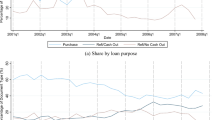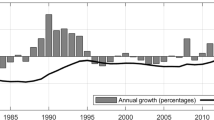Abstract
The adoption of a single EU currency market raises questions about how individual country mortgage policies are likely to affect the gains that can be realized from this larger market. We use an option pricing model to provide some perspective on this issue. We address questions such as how does the risk exposure of a mortgage guarantee program in one country compare with those in other countries? What kind of effects do any such differences or varying legal restrictions on lender recourse have? Do the programs help complete financial markets? That is, are the programs structured as unsubsidized financial intermediaries which help allocate risks? Or, are the programs essentially wards of the state which encourage risk taking? In short, we aim to provide a simple, tractable way to think about how individual country policies affect the ability to exploit the potential offered by the larger market. Our conclusions are three. First, when correctly structured, mortgage default insurance can be expected to reduce non-price rationing at an actuarially fair price. It follows that to the extent that such programs lead to more complete markets without subsidies they are also more efficient than are the many schemes now used which rely on subsidies to address mortgage market incompleteness. Second, considerable care must be exercised in the development of such instruments. In a number of countries the pricing policies do not appear to be prudent. The program terms imply either that regulators often expect a much safer economic environment than seems likely, or, alternatively, the programs have been conveying either unbudgeted subsidies or incurring contingent liabilities. Such liabilities have already been realized in Sweden, and the current exposure in the Netherlands as well as with the restructured program in Sweden, appear to be large. Finally, we find that the potential geographical risk diversification provided by the single currency market can be expected to reduce mortgage rates and improve risk allocation. However, legal, fiscal, and regulatory issues with respect to credit risk limit the ability to exploit this larger market.
Similar content being viewed by others
References
Akerlof, G. (2002). “Nobel Lecture: Behavioral Macroeconomic and Macroeconomic Behavior.” American Economic Review, June.
Ball, Michael. (2004). European Housing Review 2004, Royal Institute of Chartered Surveyors, Brussels.
Bank of Spain. (2004). Financial Stability, Madrid, Spain.
Blood, R. (2001). “Mortgage Default Insurance: Credit Enhancement for Homeownership.” Housing Finance International. 16(1), 49–59.
Borch, K. (1990). The Economics of Insurance, Amsterdam: North Holland.
Buckley, R. Karaguishiyeva, G., Van Order, R. & Vecvagare, L. (2003). “Comparing Mortgage Credit Risk Policies.” World Bank Policy Research Working Paper. 3047.
Campbell, Tim S. & Dietrich. J. K. (1983). “The Determinants of Default on Insured Conventional Residential Loans.” Journal of Finance. 38(5), 1569–1581.
Capone, C. A., Jr. (2000). “Credit Risk, Capital and Federal Housing Administration Mortgage Insurance.” Journal of Housing Research. 11(2), 373–401.
Case, K. & Shiller, R. (1996). “Mortgage Default Risk and Real Estate Prices: The Use of Index-Based Futures and Options in Real Estate.” Journal of Housing Research. 7(2), 243–57.
Case, K., Shiller, R. & Weiss, A. (1993). “Index-Based Futures and Options Markets in Real Estate.” Journal of Portfolio Management. 19(920), 83–92.
Cunningham, D. F. & Hendershott, P. H. (1984). “Pricing FHA Mortgage Default Insurance.” Working Paper 1382. National Bureau of Economic Research, Cambridge, Mass.
Deng Y., Quigley, J. M. & Van Order, R. (2000). “Mortgage Terminations, Heterogeneity and The Exercise of Mortgage Options.” Econometrica. 68(2), 275–307.
European Central Bank. (2003). Structural Factors in the EU Housing Markets, Frankfurt, Germany.
European Mortgage Federation. (2008). The Efficiency of Mortgage Collateral in the European Union, Brussels, Belgium.
European Mortgage Federation. (1988). Mortgage-Related Insurance in Europe, Brussels, Belgium.
Foster, C. & Herzog, T. (1981). “The Role of FHA.” Mortgage Banking. 41, 29–39.
Gusio, L., Japeli, R. & Terlizzesc, D. (1992). “Saving and Capital Market Imperfections: The Italian Experience.” In E. Koshela and J. Pannio (eds.) Savings Behavior: Theory, International Evidence and Policy Implications. Cambridge and Oxford, Blackwells, pp. 43–59.
Hendershott, P. & Turner, B. (1994). “The Determinants of Mortgage Default: Contrasting the American and Swedish Experiences.” Housing Finance International, pp. 25–30.
Jaffee, D. & Stiglitz, J. (1990). “Credit Rationing.” In B. M. Friedman & F. H. Hahn (eds.), Handbook of Monetary Economics, Vol. II, Elsevier Science Publishers, B.V.
Jones, L. (1993). “Deficiency Judgments and the Exercise of the Default Option in Home Mortgage Loans.” Journal of Law and Economics. April vol. XXXVI 115–138.
Kasparova, D. (2004). “Mortgage Pricing in the EU.” Paper presented at the European Network of Housing Researchers Conference, Cambridge, July 2004.
Kau, J. B., Keenan, D. C., Muller, W. J. & James, F. E. (1990). “Pricing Commercial Mortgages and Their Mortgage-backed Securities.” Journal of Real Estate Finance and Economics. 3(4), 333–356.
Maclennan, D., Muellbauer, J. & Stephens, M. (1999). “Asymmetries in Housing and Financial Market Institutions and EMU.” Oxford Review of Economic Policy. 14:3 August, 1998.
Mersman, H. (2001). “ Presentation on the Dutch National Mortgage Insurance Fund.” World Bank-Government of Lithuania Mortgage Insurance Conference. Vilnius, Lithuania. October.
Merton, Robert. (1973). “An Analytic Derivation of the Cost of Insurance Loan Guarantees.” Journal of Banking and Finance. 3–12.
Moreland Commission. (1934). Report to Herbert H. Lehman, Governor of the State of New York, New York: Author.
Pennington-Cross A. & Yezer, A. M. (2000). “The Federal Housing Administration in the New Millennium.” Journal of Housing Research. 11(2), 357–372.
Quigley, J. M. & Van Order, R. (1991). “Defaults on Mortgage Obligations and Capital Requirements for U.S Savings Institutions.” Journal of Public Economics 44, 353–369.
Schmidt-Mohr, U. (1997). “Rationing Versus Collateralization in Competitive and Monopolistic Credit Markets with Asymmetric Information.” European Economic Review. 41, 1321–1342.
Stephens, M. (2000). “Convergence in European Mortgage Systems Before and After EMU.” Journal of Housing and Built Environment. 15(1), 29–52
Tomann, H. (1990). “The Housing Market, Housing Finance and Housing Policy in West Germany: Prospects for the 1990s.” Urban Studies. 27(6), 919–930.
Turner, B., Christine, W., & Johannon, J. (1996). Report to the Swedish Government Housing Commission on Comparative Housing Finance. Stockholm, Sweden.
Author information
Authors and Affiliations
Corresponding author
Additional information
JEL Classification G22 · k23 · H81
Rights and permissions
About this article
Cite this article
Buckley, R., Karaguishiyeva, G., Van Order, R. et al. Mortgage credit risk in EU countries: Constraints on exploiting the single currency market. Eur J Law Econ 21, 13–27 (2006). https://doi.org/10.1007/s10657-006-5669-y
Issue Date:
DOI: https://doi.org/10.1007/s10657-006-5669-y




